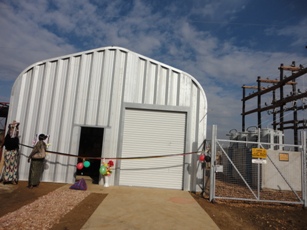S. Sudan to reinstate electricity supply to light up capital
December 5, 2017 (JUBA) – South Sudan is set to reinstate its power transmission system to light up the capital, Juba, an official said Tuesday.

“We are planning to test the electricity operation network on Dec. 16-17, and if things go well automatically we are going to operate the machines by Dec. 23,” Mathok told reporters on Tuesday.
Plans, he said, are also underway to introduce prepaid connections and meters to enable SSEC maintain and stabilize supply of power.
“We have adjusted the power tariff, examined the tariff and found out that it was one of the reasons the power supply collapsed. We have revised the tariff to be in uniform within the region like Uganda, Kenya [and] Ethiopia,” said Mathok.
According to the minister, they will cut fuel costs as the consumption will drop from 6 million liters to 2 million liters of fuel, a move that will save about 4 million liters of fuel for operating generators daily.
He further said that more electricity supply needed to light up Juba and other parts of the young nation will be boosted by the ongoing construction of new power plant along the River Nile worth 100 Mega Watts that is expected to conclude by August next year.
In October, South Sudan and neighbouring Uganda reached an understanding in an agreement that will see Kampala extend electricity to South Sudan’s border towns of Kaya and Nimule. The deal is in line with the East Africa Community Power Pool Agreement that calls on all member states to connect electricity to each other.
South Sudan, according to the electricity minister, has the lowest electricity consumption per capita in Sub-Saharan Africa compared to Uganda’s current electricity consumption of about 900MW.
However, as of March 2017, Uganda was reportedly exporting 51.1 megawatts (MW) of electricity to Kenya, 14.94MW to Tanzania and 0.27MW to the Democratic Republic of Congo. Also, besides Karuma (600MW) and Isimba (183MW), the landlocked East African country reportedly boasts of many other mini-hydropower plants, which are expected to add between 100MW and 200MW to the national grid.
South Sudan, statistics from African Development Bank (AfDB) show, has the lowest per capita electricity consumption in Africa, with a per capita consumption of between 1 to 3 kWh, compared to an average in Sub-Saharan Africa of 80 kWh. This is reportedly due partly to the underdeveloped energy infrastructure in the young nation, which has been severely impacted by decades of conflict.
According to a 2013 data, only 1% of South Sudan reportedly has access to grid electricity, due to the low level of power generation and the insufficient distribution network. Also, only 4% of urban areas are reportedly connected to power, but these areas are subject to load shedding and forced power outages.
(ST)
